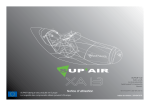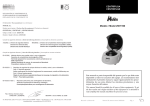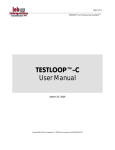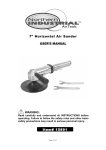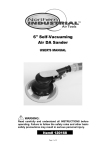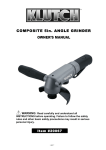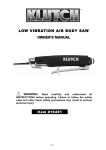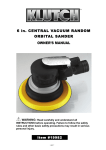Download Northern Industrial Tools 143384 User's Manual
Transcript
ROTARY HAMMER OWNER'S MANUAL WARNING: Read carefully and understand all INSTRUCTIONS before operating. Failure to follow the safety rules and other basic safety precautions may result in serious personal injury. Item # 143384 For technical questions and replacement parts, please call 1-800-222-5381. Thank you very much for choosing a NORTHERN TOOL + EQUIPMENT CO., INC. Product! For future reference, please complete the owner's record below: Model: _______________ Purchase Date: _______________ Save the receipt, warranty and these instructions. It is important that you read the entire manual to become familiar with this product before you begin using it. This machine is designed for certain applications only. Northern Tool + Equipment strongly recommends this machine is not modified and/or used for any application other than that for which it was designed. If you have any questions relative to a particular application, DO NOT use the machine until you have first contacted Northern Tool + Equipment to determine if it can or should be performed on the product. INTENDED USE The Rotary Hammer Drill is specifically designed for fast impact drilling of anchor holes and through holes for concrete and masonry. TECHNICAL SPECIFICATIONS Description Motor: No load speedd: Impacts: Specifications 120V, 60Hz, 7.6 Amps 800 RPM 3100 BPM GENERAL SAFETY RULES WARNING! Read and understand all instructions. Failure to follow all instructions listed below may result in electric shock, fire and/or serious injury. WARNING! The warnings, cautions, and instructions discussed in this instruction manual cannot cover all possible conditions or situations that could occur. It must be understood by the operator that common sense and caution are factors which cannot be built into this product, but must be supplied by the operator. SAVE THESE INSTRUCTIONS WORK AREA • Keep work area clean and well lit. Cluttered and dark work areas can cause accidents. 1 • Do not use your tool where there is a risk of causing a fire or an explosion; e.g., in the presence of flammable liquids, gasses, or dust. Power tools create sparks, which may ignite the dust or fumes. • Keep children and bystanders away while operating a power tool. Distractions can cause you to lose control, so visitors should remain at a safe distance from the work area. ELECTRICAL SAFETY WARNING! Always check to ensure the power supply corresponds to the voltage on the rating plate. • Do not abuse the cord. Never use the cord to carry the tool. Keep cord away from heat, oil, sharp edges or moving parts. Replace damaged cords immediately. Damaged cords may cause a fire and increase the risk of electric shock. • Grounded tools must be plugged into an outlet properly installed and grounded in accordance with all codes and ordinances. Never remove the grounding prong or modify the plug in any way. Do not use any adapter plugs. Check with a qualified electrician if you are in doubt as to whether the outlet is properly grounded. • Avoid body contact with grounded surfaces such as pipes, radiators, ranges, and refrigerators. There is an increase risk of electric shock if you body is grounded. • When operating a power tool outside, use an outdoor extension cord marked “W-A” or “W”. These cords are rated for outdoor use and reduce the risk of electric shock. • Do not expose power tools to rain or wet conditions. Water entering a power tool will increase the risk of electric shock. • Do not let your fingers touch the terminals of plug when installing or removing the plug to or from the outlet. PERSONAL SAFETY • Stay alert, watch what you are doing and use common sense when operating a power tool. Do not use a power tool while you are tired or under the influence of drugs, alcohol or medication. A moment of inattention while operating power tools may result in serious personal injury. • Dress properly. Do not wear loose clothing of jewelry. Keep your hair, clothing and gloves away from moving parts. Loose clothes, jewelry or long hair can be caught in moving parts. Air vents often cover moving parts and should be avoided. • Always use the appropriate ANSI Z87.1-rated eye protection and other safety equipment. Safety equipment such as dust mask, non-skid safety shoes, hardhat, or hearing protection used for appropriate conditions will reduce personal injuries. • Avoid accidental starting. Ensure the switch is in the off position before plugging tool into power outlet. Do not carry the power tool with your finger on the switch. • Do not overreach. Keep proper footing and balance at all times. This enables better control of the power tool in unexpected situations. • Remove adjusting keys or wrenches before turning the tool on. A wrench or key that is left attached to a rotating part of the tool may result in personal injury. 2 TOOL USE AND CARE • Do not force the power tool. Use the correct power tool for your application. The correct power tool will do the job better and safer at the rate for which it was designed. • Do not use the power tool if the switch does not turn it on and off. Any power tool that cannot be controlled with the switch is dangerous and must be repaired by an authorized service representative. • Disconnect the power from tool and place the switch in the locked or off position before making any adjustments, changing accessories, or storing power tools. Make sure blade has stopped. Such preventive safety measures reduce the risk of starting the power tool accidentally. • Secure work with clamps or a vise instead of your hand to hold work when practical. This safety precaution allows for proper tool operation using both hands. • Store idle power tools out of the reach of children and do not allow persons unfamiliar with the power tool or these instructions to operate the power tool. Power tools are dangerous in the hands of untrained users. • Maintain power tools. Check for misalignment or binding of moving parts, breakage of parts and any other condition that may affect the power tools operation. If damaged, have the power tool repaired before use. Many accidents are caused by poorly maintained power tools. • Use only accessories that are recommended by the manufacturer for your model. Accessories that may be suitable for one tool may create a risk of injury when used on another tool. • Keep guards in place and in working order. • Never leave tool running unattended. • Before drilling into walls, ceilings etc, ensure there are no concealed power cables or pipes in the cavity. • Always use the side handle; this gives you greater control if the accessory should become jammed. • Keep the cord clear of the accessory being used. Do not wrap the cord around your arm or wrist. • Get a good grip. Hold the tool by the insulated gripping surfaces when performing an operation where the accessory may contact hidden wiring or its own cord. • Use thick cushioned gloves and limit the exposure time by taking frequent breaks. Vibration caused by the hammer action may be harmful to your hands and arms. • When removing an accessory from the tool, avoid contact with skin and use proper protective gloves when grasping the bit or accessory. Accessories may be hot after prolonged use. • Always wear eye protection and a dust mask, especially for dusty applications and when drilling / chiseling overhead. Sanding particles can be absorbed by your eyes and inhaled easily and may cause health complications. WARNING! The use of any accessory or attachment, or performance of any operation with this tool other than those recommended in this instruction manual may present a risk of personal injury. 3 OPERATION BEFORE ATTACHING OR REMOVING ANY ACCESSORIES BE SURE TO DISCONNECT THE HAMMER DRILL FROM THE POWER SUPPLY. 4 Fitting and changing tools (Fig.2) The device is equipped with a SDS-plus attachment system. • clean tools and grease with a thin layer of machine grease before fitting. • Pull back fastening sleeve (A, Fig.2) and hold. • Push and rotate the dust-free tool into the tool holder as far as it will go. The tool will lock automatically. • Check that it has locked by pulling the tool. Removing SDS-plus tool (Fig.3) Pull back fastening sleeve (A), hold and remove the tool. Starting work (Fig.1) Switching ON/OFF • switching on: Press the operating switch (3). • switching off: Press the operating switch (3) briefly and let go. 5 Handle attachment (Fig.4) For safety reasons, only use the hammer drill with handle attachment. You will be able to achieve a safe body position during operation by rotating the handle attachment. Loosen and turn the handle attachment in an counterclockwise direction. Then tighten the handle attachment. Depth stop (Fig.5) Loosen the handle attachment and place the straight part of the depth stop into the hole. Adjust the depth stop and re-tighten the handle attachment. Dust collection device (Fig. 6) Before doing any overhead hammer-drilling work, attach the dust-collecting cup over the drill bit. Drill Stop (Fig.8) • You can deactivate the drilling action of the hammer drill when using it for chiseling work. • Turn the lever selector (7) so that the mark “T T” coincides with the arrow (a) on the machine case. • To reactivate the drilling action, the lever selector (8) has to be reset so that the mark (b) “II T” coincides with the arrow (a). Important! Too much pressure will place unnecessary load on the motor. Check the drill bits regularly. Re-sharpen or replace blunt drill bits. MAINTENANCE • The grease in the gearbox will require replenishment after approximately 50 hours accumulative use. After this time add approximately 50 grams of the grease (supplied), into the gearbox. First remove the cap from the tool by using the pin spanner (supplied). Once removed add the grease through this hole. Ensure the cap is secured back into position prior to operation. • After each use, blow air through the tool housing to ensure it is free from all dust particles that may build up. Build up of dust particles may cause the tool to overheat and fail. • If the housing of the tool requires cleaning do not use solvents but a moist soft cloth only. Never let any liquid get inside the tool; never immerse any part of the tool into a liquid. • When the carbon brushes wear out the tool will spark and/or stop. The brushes are a wearing component of the tool and should be replaced prior to the carbon wearing out fully. Brushes will wear out after many uses. Always replace both brushes at the same time. Note: Northern Industries will not be responsible for any damage or injuries caused by the repair of the tool by an unauthorized person or by mishandling of the tool. 6 PARTS DRAWING 7 PARTS LIST 8











